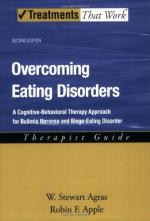|
This section contains 774 words (approx. 3 pages at 300 words per page) |

|
Since 1980, bulimia nervosa has been recognized by the American Psychiatric Association as an autonomous eating disorder. The term bulimia means "an extreme hunger," but the word is most commonly understood to refer to BULIMIA NERVOSA. It is characterized by recurrent episodes of binge eating followed by such regular activities as self-induced vomiting, excessive use of laxatives and/or diuretics, fasting or dieting, and vigorous exercise—all of which are directed at weight control. A characteristic feature in the bulimic patient is a persistent concern with weight and body shape. Other psychiatric disorders can accompany bulimia, particularly major depression. The full syndrome affects 1 to 3 percent of the adolescent and young adult female population, but many more experience subclinical variants of the disorder. Bulimia nervosa does occur in males, but such incidence is rare.
This disturbance in eating affects mostly young women—usually women of normal weight—and...
|
This section contains 774 words (approx. 3 pages at 300 words per page) |

|


